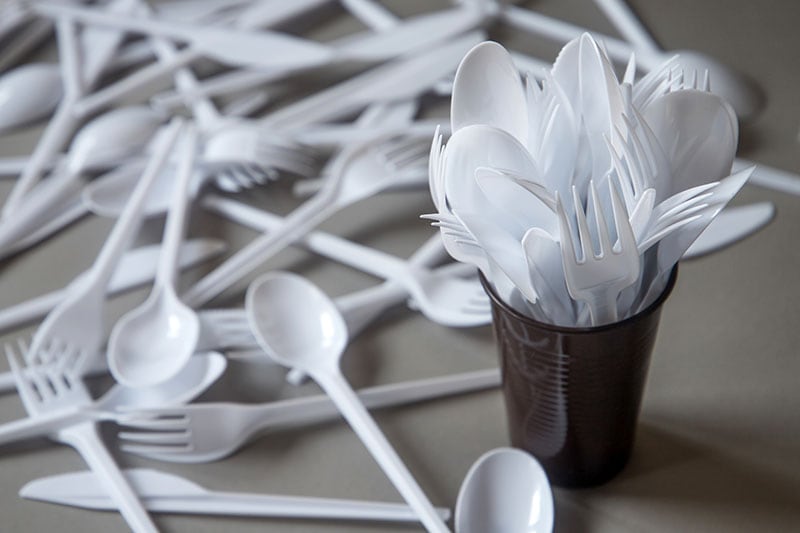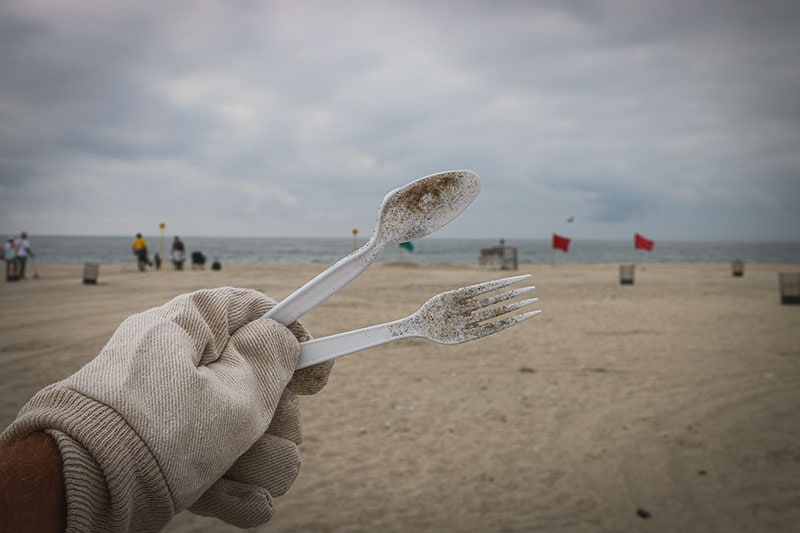Are Plastic Utensils Recyclable? How Do You Properly Dispose of Them?
-

- Last updated:

One concern among environmentalists is whether plastic utensils are recyclable. Sure, some plastic utensils are recyclable, but other plastic types are not. Since it is hard to know which type of plastic is used, you should check the label before you dispose of them in a recycling bin. Besides the composition of your plastic utensils, other variables determine the recyclability of plastic utensils.
In this article, we will discuss why some plastic utensils are recyclable while some are not. We will also investigate the proper way of disposing of plastic utensils that cannot be recycled. Read on to learn more.
Classification of the Plastics Used on Utensils
Plastic utensils can have adverse effects on the environment, and it is our responsibility to dispose of them properly.
We should use recycled plastic utensil materials to reduce our contribution to environmental degradation. Unfortunately, not all plastic utensils can be recycled.
However, finding the type of plastic used on your utensils is no easy task. Besides that, there isn’t much that you can do without prior knowledge of the different plastic types and which ones are recyclable. In the recycling industry, plastic is given categories that range from 1 to 7.
Out of all of them, plastic 1, 2, and 5 are recyclable, while the rest cannot.
- Category 1: Polyethylene Terephthalate (PET) includes water bottles and plastic trays.
- Category 2: High-Density Polyethylene (HDPE) includes milk cartons and shampoo bottles.
- Category 5: Polypropylene (PP) includes margarine tubs and ready-to-eat meal trays.
Plastic products from these three categories are accepted at almost every recycling plant. Therefore, if you use utensils from these plastic types, you can simply toss them in a recycling bin. However, it is difficult to ascertain what category your utensils fall into since most of them don’t come with numbers or feature recycling symbols on their packaging. Without knowing what category your utensils fall into, you cannot send them for recycling.

Here are some common plastic utensils that you can recycle:
- Plastic spoons: If you enjoy eating your meals with a plastic spoon instead of silver ones, you will be happy to know that this plastic type is recyclable.
- Plastic fork: Eating utensils made from recyclable plastics are also referred to as Plastic silverware. Plastic forks are a type of plastic silverware and are simple enough to recycle.
- Other plastic utensils: Recyclable Plastic materials fall in the primary category of 1 to 2. However, some circles claim that plastic silverware that falls into category 6, especially plastic plates, can also be recycled.
Which Plastic Utensils Cannot Be Recycled?
Generally, plastic utensils that fall into categories 3, 4, 6, and 7 or bioplastics are not universally recyclable.
- Category 3: Polyvinyl Chloride (PVC) includes piping materials
- Category 4: Low-Density Polyethylene (LDPE) includes shopping and food bags
- Category 6: Polystyrene (PS) includes plastic cutlery
- Category 7: Other (BPA, Polycarbonate and LEXAN)
Plastics in category 6 are usually lightweight, inexpensive, and sturdy. This is perhaps why most plastic utensils, egg cartons, take-out containers, and disposable plates and cups feature materials from category six plastic. Some companies may be able to recycle utensils from this category; however, it is quite challenging due to polystyrene. This compound deteriorates easily and disperses into the environment.
Moreover, products made from the compound may produce styrene, a toxic human carcinogen. Since recycling plants for polystyrene products are not readily available, category six plastic utensils account for about 35% of US landfills which adds to the pollution problem.
While you cannot recycle LDPE, PVC, and PS plastics, some modernized and advanced facilities are now accepting them for recycling. To confirm, visit a local facility or do an online search for facilities that accept all types of plastics.
Besides category 6, plastic utensils made from composite plastics, bioplastics, plastic-coated wrapping paper, and polycarbonate are also not recyclable.
Why Are Some Plastic Utensils Not Recyclable?
As you may have gathered by now, some plastic categories are recyclable while some are not. This can be attributed to several reasons:
Sorting Constraints

One of the main reasons some plastic utensils are not viable for recycling is the fact that the Material Recovery Facility (MRF) lacks the manpower to sort them out properly. The MRF is tasked with sorting different items for disposal. They do this by sorting through products based on packaging, shipment, and materials. Usually, when items are packaged together, they are compressed into some mulch.
However, this is not possible with plastic utensils. If you try to crumble plastic knives, forks, and spoons, they will only break down into small liters. This will only increase the chances of jamming up the recycling plant.
Furthermore, most plastic utensils are the root course of contamination at the MRF. Since plastic utensils cannot be filtered and treated like other recyclable materials, sending them to a recycling plant remains challenging.
The Shape of the Plastic Utensils
Different plastic utensils come in various shapes and sizes. However, some are very small and can create problems at the recycling plant. They can easily break inside the machine and jam the recycling system.
Furthermore, some plastic utensils are extremely lightweight and are sometimes confused with materials such as paper. It is a common problem in recycling plants and often results in the two materials being processed together. If this happens, it can contaminate other recyclables in the plant.
Exporting Plastics
Some plastic utensils are rigid plastics when delivered for recycling. Rigid plastics include yogurt containers, blister packs, and clamshell packaging. While common plastic products such as plastic bags and bottles are recycled domestically, rigid plastics are exported to China for recycling.
However, for the last few years, China has been trying to reduce the number of plastics brought into the country. Eventually, this will impact all rigid plastic recycling endeavors in the United States. Even towns that normally accept plastic utensils for recycling will stop if the local recycling market doesn’t develop and thrive.
So, you may or may not be able to recycle your plastic utensils, depending on your locality.
How to Properly Dispose of Unrecyclable Plastic Utensils
Due to their availability and cheap costs, plastic utensils can easily accumulate in your house. Whether you recently hosted a party or are a regular take-out customer, you may end up with a pile of unwanted utensils that you may need to get rid of.
Recycling plastic utensils is still the best option, but since recycling plastic utensils is a bit challenging, there are other options that you could choose from.
1. Give them away
Giving plastic utensils that you no longer want to needy people is one way of keeping them from going to waste. You can make a charitable donation to the myriad of non-profit groups that regularly host events to support the less fortunate.
So, you can support their cause by donating disposable plates and cups for use on such occasions. Alternatively, you can give the disposables to your local homeless population.
2. Use as bookmarks
Did you know that you can use your plastic spoon and fork handles to make bookmarks? Yes, you can. Since most plastic utensils come in various colors and hues, the options for using them as bookmarks are endless.
Simply cut the spoon/fork part off, then file the jagged edges. Once done, you will have several utensil handles that you can use to identify your last page in books. What’s more, you can create several art projects with the fork and spoon tops removed.
3. Save them for future use
Another great option is saving them for the next social gathering. In such events, everyone needs a supply of food and entertainment. Since your guests cannot wolf down your entire buffet, they would need some cutlery to hold food, and plastic varieties work great. You could also give them to a friend throwing a party or bring them to your next office meeting.
Conclusion
As you may have gathered, disposing of plastic utensils is challenging and limited. While plastic utensils are convenient, if not properly disposed they can have unintended consequences for marine life, wildlife, and the general environment. Some plastic utensils are recyclable in most recycling plants. These plastics fall into categories 1, 2, and 5. However, utensils made from plastics from categories 3, 4, 6, and 7 are not recyclable.
It is challenging to recycle plastic utensils for two main reasons. First, due to their skinny and small shape, the utensils are likely to get stuck or fall through the machine that sorts items into groups of similar materials. Second, plastic utensils vary in terms of the type of plastic used. Because most of them are identical in size and shape, the different types make it difficult for the MRF to sort through correctly.
If your plastic utensils are not recyclable, you can get rid of them by making spoon rivers, using them as bookmarks, or donating them to the needy. You could also save them for future use. Alternatively, you can embrace a zero-waste lifestyle by limiting the amount of plastic used daily. This involves the use of sustainable materials such as bamboo that are biodegradable when they conclude their lifespan.
Featured Image Credit: Marcinm111, Shutterstock
Contents


